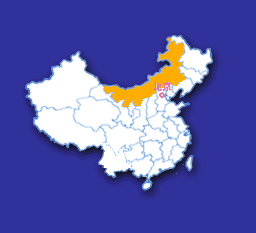
 |
Inner
Mongolia
|

|
|||||||||||
|
|||||||||||
|
|||||||||||
|
Elevation Climate Natural resources Animals
and plants: Hydropower: Forests,
grasslands, and cultivated land: Minerals:
Tourism
Environment
and current policies: The desertification and alkalization of grasslands have brought frequent sandstorms. The deterioration of water conservation capacity of the Greater Hinggan Mountains has resulted in floods in the Songhua and Liaohe river valleys. Each year 300 million tons of soil are washed away in the Yellow and western Liaohe rivers, or 30,000 hectares of land lost. As a result, rivers are choked with silt that stops their flow. To improve ecological environment, the Ecological Construction Project, one of the ten projects of the western development campaign, has been launched recently in the region which includes turning the cultivated land into forests and grasslands, planting grass and suspending animal husbandry, shelterbelts in the northeast, northwest and the north, anti-desertification, virgin forest protection in the Greater Hinggan Mountains, and resettlement. It is expected that by 2005 the deteriorated eco-environment can be brought under control, with first steps at reclamation achieved by 2010, and that mountains will be green and rivers clear again by mid-century.
|
||
|
II.
Population and ethnicity
|
||
|
Population growth rate: 9.7?? Life expectancy (average): Ethnicity: Education: In 2000 the region had 10,147 primary schools in 6,299 places, 1,707 middle schools including 1,330 junior secondary schools and 377 senior secondary schools, 425 polytechnic middle schools including 269 junior polytechnic secondary schools and 156 senior polytechnic secondary schools, 18 universities and colleges, and 12 adult-education schools.
|
||
|
III. Economy
|
||
|
GDP: 140 billion yuan (US$16.9 billion) (2000) GDP growth rate: 9.7 percent (2000) and averaging increasing rate of 10 percent during the ninth Five-Year Plan (1996-2000) Average GDP per capita: 5,350 yuan (US$646) (1999) Urban and rural income: From 1989 to 1997 Inner Mongolia was the poorest in China in terms of the disposable per capita income of urbanites and rural residents. In 1999 it ranked 22nd in the country. In 2000 the disposable per capita income of urbanites and rural residents amounted to 5,120 yuan (US$618), 7.3 percent up over the previous year, a 58.9 percent increase over the end of eighth Five-Year Plan period (1991-95), and averaging an annual increase of 9.7 percent. The average per capita income of rural residents hit 2,050 yuan (US$248), with an annual increasing rate of 5 percent. GDP ratio (1st, 2nd, and tertiary industries): 25:39:36 (2000) Added value and growth rate (1st, 2nd, and tertiary industries) (2000): 35.2 billion yuan (US$4.25 billion), 55.2 billion yuan (US$6.67), and 49.6 billion yuan (US$5.99 billion) respectively; 2.6 percent, 12.3 percent, and 11.6 percent increase over the previous year respectively; averaging annual increase rate of 6.4 percent, 11.7 percent, 10.7 percent during the ninth Five-Year Plan (1996-2000). Poverty-alleviation
plan Inflation rate (2000): consumption price 1.3 percent up over the previous year. Unemployment rate: 3.34 percent (2000) Revenues: 15.56 billion yuan (US$1.9 billion) (2000), doubling that by the end of eighth Five-Year Plan period and with an annual increasing rate of 15.3 percent; local revenues being 11 billion yuan (US$1.3 billion) with an annual increasing rate of 20.4 percent. Foreign
trade Foreign
investment Key
industries
|
||
|
IV.
Post and Telecom
|
||
|
|
Telecom
and telephones: Radio
and TV stations
|
|
|
V.
Transportation
|
||
|
Highway Airport |
||
|
VI.
Major fields and projects wanting foreign investment
|
||
|
Projects
available to foreign investment |
||
|
VII.
Favorable policies for foreign investment
|
||
|
??
Article
2 Article
3 Article 4 Inner Mongolia encourages the establishment of foreign invested enterprises involving large investment. 1)
The foreign-funded productive and hi-tech enterprises established in
the development zones, regional capital, and border cities with approval
by the State Council shall be levied the same income tax as foreign-funded
and foreign enterprises in China's coastal opening cities and development
zones. Article
5 Article
6 Article
7 Article
8 Article
9 Article
10 Article
11 Article
12 Article
13 Article
14 Article
15 Article
16 Article
17 Article
18 Article
19 Article
20 1)
No inspection and punishment is allowed to be given to the foreign invested
enterprises without the guideline of laws, rules, and regulation. Article
21 Article
22
|
||
主站蜘蛛池模板: 一级毛片成人午夜| 五月天婷婷伊人| 一区二区国产在线播放| 欧美浓毛大泬视频| 动漫美女和男人羞羞漫画| 视频aavvmm国产野外| 在线播放免费播放av片| 三级黄色在线免费观看| 日本性视频网站| 久草热久草视频| 欧美人体一区二区三区| 十六一下岁女子毛片免费| 调教女m视频免费区| 国产日产卡一卡二乱码| 探花视频在线看视频| 成人毛片100免费观看| 久久人人妻人人做人人爽| 最新版天堂中文在线| 亚洲国产成a人v在线观看| 美国十次啦大导航| 国产丰满老熟女重口对白| 黄床大片免费30分钟国产精品| 国产精品久久久久网站| 7777精品伊人久久久大香线蕉| 成在人线av无码免费高潮水| 亚洲日韩乱码中文字幕| 特级精品毛片免费观看| 免费无码又爽又刺激网站| 精品无码一区二区三区爱欲九九| 国产一区二区不卡老阿姨| 野花社区视频在线观看| 国产国语一级毛片在线放| 97国产在线播放| 国产毛片哪里有| 亚洲www视频| 国产熟女一区二区三区五月婷| 香蕉视频一区二区| 天天操天天干视频| 一区二区三区中文字幕| 婷婷伊人五月天| 一区二区三区四区无限乱码|